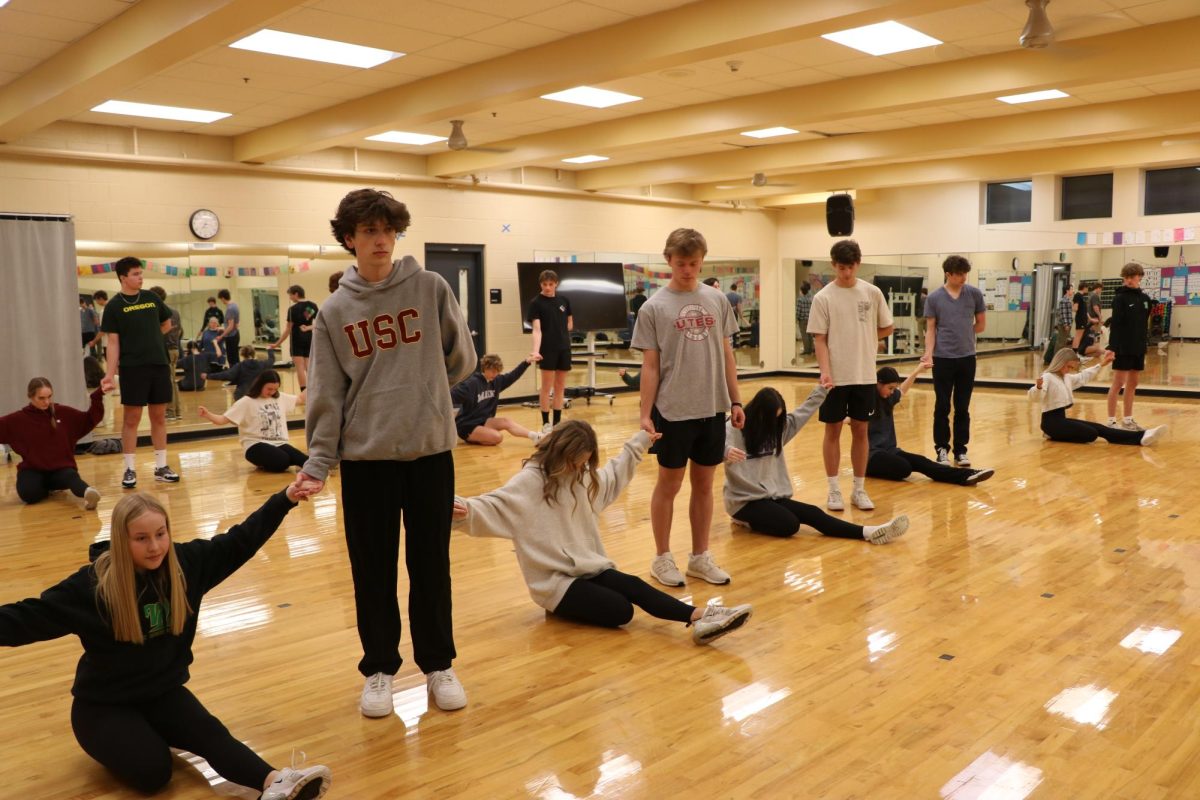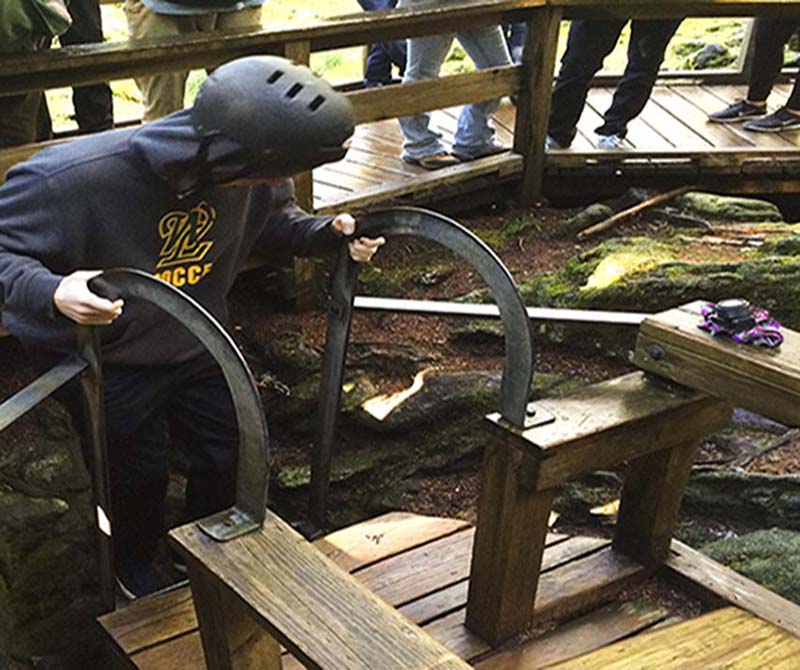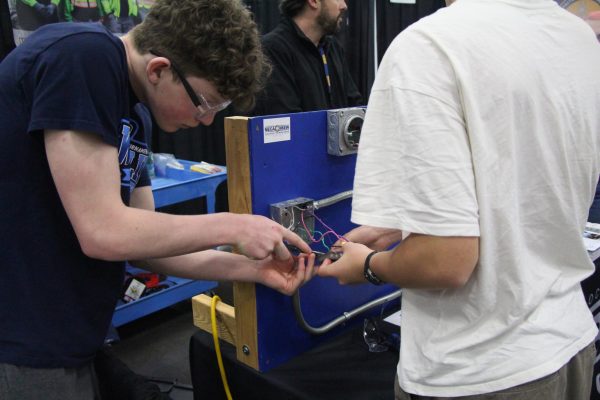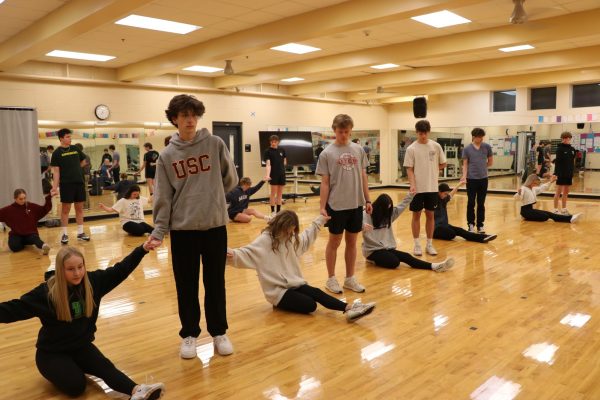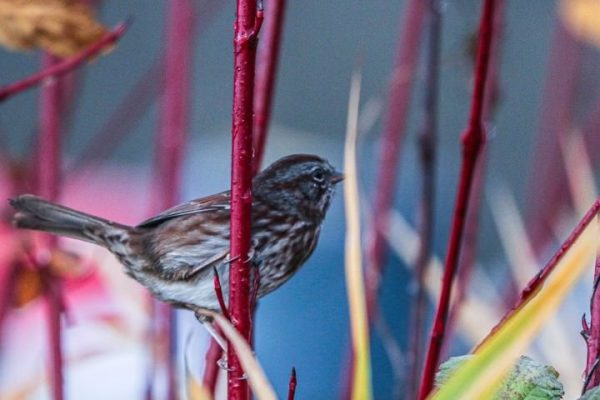Ravin’ About Cavin’
Geology students explore Lake Cave below the south side of Mt. St. Helens.
Early Monday morning, students of Jim Hartmann’s geology classes boarded a bus bound for the Mt. St. Helens area. After a 45 minute ride, we stopped at Burgerville for breakfast as we took a break to prep for the second half of the journey and our caving adventures later that day. After finishing breakfast, we took our seats for the last hour of the drive as we traversed through windy roads and along the way, saw glimpses of Mt St Helens. A blanket of clouds made seeing the mountain difficult, as we were only granted a glimpse the bottom half of it. Parking at the Trail of Two Forests Trailhead, we traversed along a boardwalk in search of the cave.
Walking along a boardwalk, Hartmann pointed out lava tubes that were formed in the ground, along with tree casts. Trailing away from the boardwalk, he led the way through the dense forest until we finally reached the opening of Lake Cave. As we descended into the mouth of the cave, the temperature immediately fell to a cool 42 degrees Fahrenheit and what natural light we had quickly vanished.
“This was the first time I had ever been in a lava tube cave,” Andres Cruz, senior, said. “I didn’t know what to expect.”
The first challenge to meet us was a 30 ft. drop deeper into the cave. Our only way down was a rickety ladder bolted to the rock with some rusty chains. Swinging out over the edge, our only visual aid was an LED head lamp that we hoped wouldn’t spring off of our helmet and into the darkness.
After we made it to the bottom, we turned our noses to the darkness the cave offered and continued farther in. For some context, Lake Cave is a cave formed when lava moves underneath the hardened surface of a lava flow. The lava that formed this cave drained from Mt St Helens into the surrounding earth.
Walking along, we could see waves of rock that had solidified from the lava that flowed hundreds or even thousands of years ago. Occasionally, enormous rocks emerged from the darkness that required either climbing over, or squeezing below, pressing our bodies against the cold rock and hoping we didn’t lose our nerves.
The most unnerving moment was yet to come. As we walked along in the pitch black minus the blue glow of our headlamps, a treacherous obstacle showed itself. Rocks had piled up in front of us and our only way around them was down. A 2.5 ft wide hole was what we had to work with and a seven foot drop made the challenge even more anxiety inducing. Carefully maneuvering, we had to watch every movement as slipping was a great possibility. Fortunately, we eased our way to the ground and no one had too much trouble.
“I thought that the tight fit was really creepy,” Cruz said. “I was also not expecting the drop to be so high.”
The rest of the journey was uneventful compared to the first part. One moment that sent everyone’s heart pounding in their heads though, was side pockets that were formed in the walls of the cave. We had a choice of either going into the left pocket or the right one. At first, I had hoped to go through the right one but the fit was too tight and my claustrophobia screamed out, “NO!”.
“The right pocket was fun because of how challenging it was, especially since we had to crawl and maneuver ourselves in tight places,” Cruz said.
Crawling through the left pocket with another student, we were able to move up to a crouching position but that was about it. Further and further we went and rock began to close in on us. Eventually, we made it to a dead end and rested for a couple minutes. Turning our lights off, we were met with an absolute and unbroken darkness which swallowed us.
There was utter silence other than our breathing and water dripping through the cracks in the rock. After a few seconds of pitch blackness, we turned our lights off, exited the side pocket, and started the arduous trek back to the opening of Lake Cave.
Hartmann’s motivation to take students to the cave was educational along with the experience being incredibly unique.
“We went with a purpose of exploring geological features, especially since we’re studying volcanic rocks in class,” Hartmann said. “There’s not a whole lot of places in the world that offer the amount of caves that the Pacific Northwest does.”
While learning, especially in high school, has been restricted to desks and books, Hartmann feels it important to go out in the field and witness caves firsthand.
“It’s really an adventure and I hope it creates an inspiration in geology along with its processes.” Hartmann said. “It’s also a way to have an adventure.”
The final geology field trip of the semester was this caving trip, and students were happy to go out on a “rockin” trip.
“Hartmann said if we went on this we’d be “lavin” it,” Cruz said. “He wasn’t wrong.”
Your donation will support the student journalists of West Linn High School. Your contribution will allow us to continue to produce quality content by purchasing equipment, software, and continuing to host our website on School Newspapers Online (SNO).

Before Walker McCrae, senior, realized his dream of becoming a sports manager, he was faced with one task, one court and one orange leather ball.
“Walker!...


























![Game, set, and match. Corbin Atchley, sophomore, high fives Sanam Sidhu, freshman, after a rally with other club members. “I just joined [the club],” Sidhu said. “[I heard about it] on Instagram, they always post about it, I’ve been wanting to come. My parents used to play [net sports] too and they taught us, and then I learned from my brother.”](https://wlhsnow.com/wp-content/uploads/2024/03/MG_7715-2-1200x800.jpg)





![The teams prepare to start another play with just a few minutes left in the first half. The Lions were in the lead at halftime with a score of 27-0. At half time, the team went back to the locker rooms. “[We ate] orange slices,” Malos said. “[Then] our team came out and got the win.”](https://wlhsnow.com/wp-content/uploads/2023/10/IMG_2385-1200x800.jpg)





![At the bottom of the third inning, the Lions are still scoreless. Rowe stands at home plate, preparing to bat, while Vandenbrink stands off to the side as the next batter up. Despite having the bases loaded, the team was unable to score any runs. “It’s just the beginning of the season. We’re just going to be playing out best by June, [and] that’s where champions are,” Rowe said.](https://wlhsnow.com/wp-content/uploads/2024/03/IMG_3077-1200x900.jpg)








